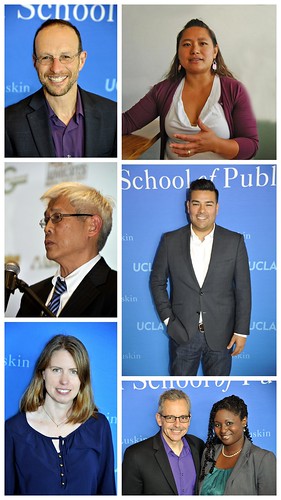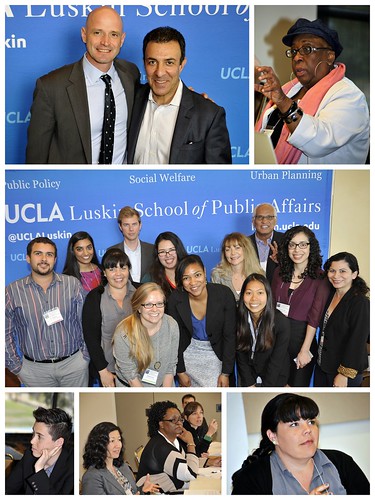Convening Advances Path Forward for Investment Justice from the Greenhouse Gas Reduction Fund
By Adeney Zo, UCLA Luskin Student Writer, and
Colleen Callahan, Luskin Center
The Luskin Center convened 150 leaders in government, nonprofits, academia and the private sector on March 21 for a workshop designed to advance climate action in disadvantaged communities. California’s Greenhouse Gas Reduction Fund is expected to generate tens of billions of dollars over the next decade to mitigate climate change and create local benefits. Senate Bill 535 (de León) requires that 25 percent of these monies go to projects that provide benefits to disadvantaged communities in California.
“This may be the largest environmental investment opportunity that these communities will see for decades,” stated J.R. DeShazo, director of the Luskin Center as he opened the workshop held at UCLA.
But many questions exist about revenue allocation and implementation. The Luskin Center hosted convening supported the development of an analytical and equitable approach for this process. Participants helped identify and refine evaluative criteria to guide investment decisions and performance metrics to track results of the investments for accountability and transparency. A summary of recommendations for a performance metrics tool will be released by UCLA later this year. The convening was a partnership with the SB 535 Quad.
What’s at Stake
 State Senator Ricardo Lara’s keynote address underscored what is at stake. Millions of Californians are struggling economically and breathing dirty air while climate change will exacerbate economic and environmental health risks. Charles Lee, a national environmental justice leader with the U.S. Environmental Protection Agency, put the event in a national context, stating that environmental actions in California become models for the rest of the nation.
State Senator Ricardo Lara’s keynote address underscored what is at stake. Millions of Californians are struggling economically and breathing dirty air while climate change will exacerbate economic and environmental health risks. Charles Lee, a national environmental justice leader with the U.S. Environmental Protection Agency, put the event in a national context, stating that environmental actions in California become models for the rest of the nation.
“We are here to build on the momentum started by many of you in this room who organized to pass SB 535, and are now working to fulfill the State’s promise to invest cap-and-trade revenues to benefit California’s disadvantaged communities,” DeShazo added.
Among these leaders were Marybelle Nzegwu at Public Advocates, who introduced Senator Lara’s keynote address at the workshop, along with Bill Magavern, policy director of Coalition for Clean Air, and Mari Rose Taruc, state organizing director for the Asian Pacific Environmental Network. Mari Rose and Bill presented on the key laws in California including: AB 32, the Global Warming Solutions Act of 2006 that led to the cap-and-trade program, as well as SB 535 and AB 1532, which require that cap-and-trade revenues result in environmental, public health, and economic benefits for communities in need.
“We know the people in California that will be the most hurt by climate change are people with the least resources to face this problem,” stated Taruc. Yet as Magavern pointed out, the State has not yet defined what it means for an investment to “benefit disadvantaged communities,” and thus we need funding criteria and tracking mechanisms to verify that these investments are truly benefiting hard hit communities.
Implementation of a Landmark Law
Clifford Rechtschaffen, senior advisor for Governor Brown, spoke about the process and opportunities for SB 535 implementation. “We must make the disadvantaged community investment process inclusive, transparent, and accountable,” he stated while disclosing the State’s intent to hold public workshops on SB 535 implementation.
Rechtschaffen also discussed CalEnviroScreen, a tool the State developed to identify disadvantaged communities for the purpose of SB 535 implementation. “CalEnviroScreen can help the cap-and-trade program go to communities that most need it,” stated Rechtschaffen. Manuel Pastor, professor and director of the Program for Regional and Environmental Equity at USC, underscored the importance of this tool, which his research helped inform. The State’s tool measures cumulative risk, using a variety of environmental health and socioeconomic indicators.
Informing an Equitable and Performance-based Approach for Investment Benefits in Disadvantaged Communities
 Paving the way for the workgroups, Pastor then explained that each participant was grouped into one of six investment-sector focused sessions: 1) Sustainable Communities Strategies Implementation; 2) Low-Carbon Freight Transport; 3) Zero-Emission Passenger Transportation; 4) Energy Efficiency and Residential Weatherization; 5) Clean Renewable Energy; and 6) Community Greening and Forestry.
Paving the way for the workgroups, Pastor then explained that each participant was grouped into one of six investment-sector focused sessions: 1) Sustainable Communities Strategies Implementation; 2) Low-Carbon Freight Transport; 3) Zero-Emission Passenger Transportation; 4) Energy Efficiency and Residential Weatherization; 5) Clean Renewable Energy; and 6) Community Greening and Forestry.
The charge for participants was to serve as policy analysts within their investment sector area. Pastor implied that the agenda for the workgroups was ambitiously aligned with a complex State process, but employed participants not to be intimidated by it. He spotlighted the important perspective of the environmental justice and community leaders in attendance.
The Greenlining Institute’s Vien Truong then made a presentation on “Criteria and Metrics.” Truong defined the terms as: “Principles capture broad goals, criteria are the objectives, and metrics are how we get there.” She proposed five criteria to drive funding allocation at the program level. The criteria were compiled by the UCLA Luskin Center and the SB 535 Quad, and derived from the relevant laws.
The breakout sessions that followed were designed to allow participants to refine the criteria and propose corresponding metrics. Each group discussed programs in their investment sector for which the criteria and metrics could be applied. Each of the six sessions began with presentations from State agency leaders who spoke about existing programs eligible for funding from the Greenhouse Gas Reduction Fund, per the State’s current Investment Plan. The groups then identified whether there were programs in their investment sector not on the table that should be eligible for funding in future three-year investment cycles. Finally, each group provided recommendations on how programs could best be implemented to benefit disadvantaged communities.
Recommendations and Next Steps
 After hours of discussion, the six groups came back together. Colleen Callahan, deputy director of the Luskin Center, facilitated a panel in which a representative from each group summarized their discussion. Common themes across the groups included the importance of transparency and authentic community engagement; and leveraging of complementary programs across sectors. Proceedings from these discussions will be included in a report that the Luskin Center will release later this year.
After hours of discussion, the six groups came back together. Colleen Callahan, deputy director of the Luskin Center, facilitated a panel in which a representative from each group summarized their discussion. Common themes across the groups included the importance of transparency and authentic community engagement; and leveraging of complementary programs across sectors. Proceedings from these discussions will be included in a report that the Luskin Center will release later this year.
To close out the workshop, a panel of government agency leaders shared how their agencies will approach the opportunity that SB 535 presents. Arsenio Mataka, assistant secretary of environmental justice and tribal affairs at Cal/EPA, summarized the workshop’s importance: “Our goal is helping communities with a sense of hopelessness. If we do our job to meet our requirements to reduce GHG, we can achieve investment justice.”
Hector De La Torre, board member of the California Air Resources Board, emphasized the need to show immediate results to fend off law suits. “We need to show the money is going to the things the law says it will go to,” De La Torre said. Chief Ken Pimlott, director of the California Department of Forestry & Fire Protection, proposed that urban forestry could be a solution to the need for immediate results. “The state has a proven track record investing in urban forestry, and we can show results through projects in urban forestry,” Pimlott said.
Catherine J.K. Sandoval, commissioner of the California Public Utilities Commission referred to the importance of selecting appropriate existing programs to fund and in the longer-term, even updating or adding new programs to best address the needs of disadvantaged communities.
Linda M. Wheaton of the California Department of Housing and Community Development emphasized the importance of the convening, stating,“It is time to take advantage of collaboration to develop inclusive and sustainable communities.”
J.R. DeShazo closed the workshop with a call for continued collaboration. He invited attendees to provide additional comments and review the post-workshop report. This report will contain recommendations for the State to achieve investment justice from the Greenhouse Gas Reduction Fund, to ensure that the investments combat climate change while providing tangible local benefits to hard hit communities.

Leave a Reply
Want to join the discussion?Feel free to contribute!